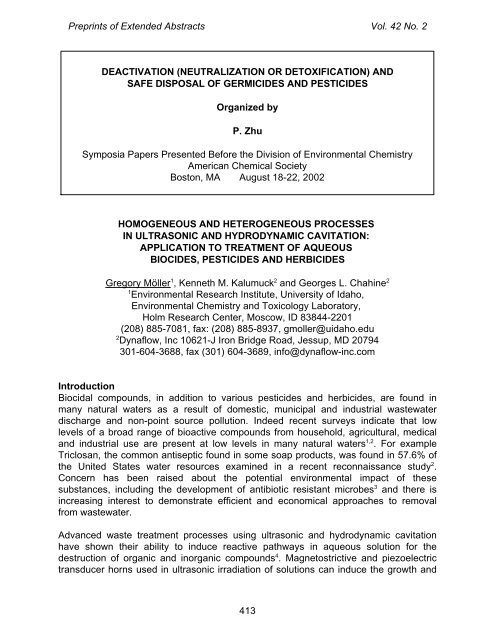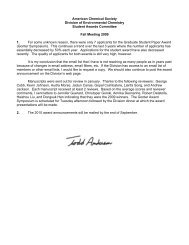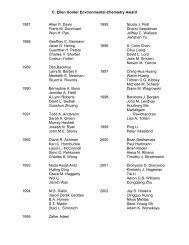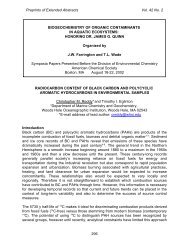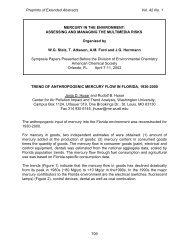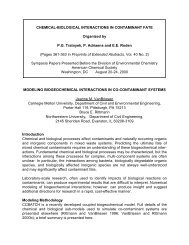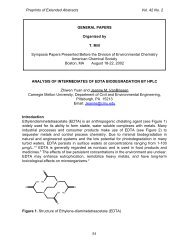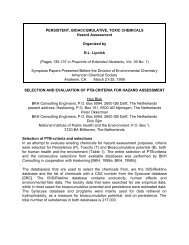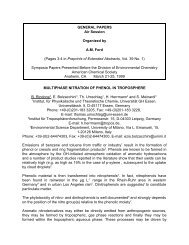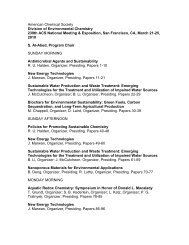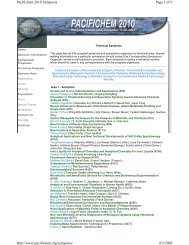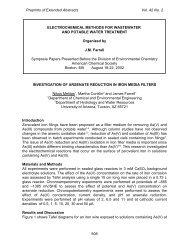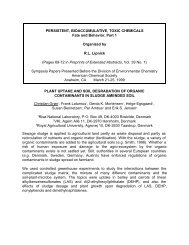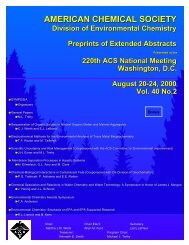paper 46 - ACS: Division of Environmental Chemistry
paper 46 - ACS: Division of Environmental Chemistry
paper 46 - ACS: Division of Environmental Chemistry
You also want an ePaper? Increase the reach of your titles
YUMPU automatically turns print PDFs into web optimized ePapers that Google loves.
Preprints <strong>of</strong> Extended Abstracts Vol. 42 No. 2<br />
DEACTIVATION (NEUTRALIZATION OR DETOXIFICATION) AND<br />
SAFE DISPOSAL OF GERMICIDES AND PESTICIDES<br />
Organized by<br />
P. Zhu<br />
Symposia Papers Presented Before the <strong>Division</strong> <strong>of</strong> <strong>Environmental</strong> <strong>Chemistry</strong><br />
American Chemical Society<br />
Boston, MA August 18-22, 2002<br />
HOMOGENEOUS AND HETEROGENEOUS PROCESSES<br />
IN ULTRASONIC AND HYDRODYNAMIC CAVITATION:<br />
APPLICATION TO TREATMENT OF AQUEOUS<br />
BIOCIDES, PESTICIDES AND HERBICIDES<br />
Gregory Möller 1 , Kenneth M. Kalumuck 2 and Georges L. Chahine 2<br />
1 <strong>Environmental</strong> Research Institute, University <strong>of</strong> Idaho,<br />
<strong>Environmental</strong> <strong>Chemistry</strong> and Toxicology Laboratory,<br />
Holm Research Center, Moscow, ID 83844-2201<br />
(208) 885-7081, fax: (208) 885-8937, gmoller@uidaho.edu<br />
2 Dynaflow, Inc 10621-J Iron Bridge Road, Jessup, MD 20794<br />
301-604-3688, fax (301) 604-3689, info@dynaflow-inc.com<br />
Introduction<br />
Biocidal compounds, in addition to various pesticides and herbicides, are found in<br />
many natural waters as a result <strong>of</strong> domestic, municipal and industrial wastewater<br />
discharge and non-point source pollution. Indeed recent surveys indicate that low<br />
levels <strong>of</strong> a broad range <strong>of</strong> bioactive compounds from household, agricultural, medical<br />
and industrial use are present at low levels in many natural waters 1,2 . For example<br />
Triclosan, the common antiseptic found in some soap products, was found in 57.6% <strong>of</strong><br />
the United States water resources examined in a recent reconnaissance study 2 .<br />
Concern has been raised about the potential environmental impact <strong>of</strong> these<br />
substances, including the development <strong>of</strong> antibiotic resistant microbes 3 and there is<br />
increasing interest to demonstrate efficient and economical approaches to removal<br />
from wastewater.<br />
Advanced waste treatment processes using ultrasonic and hydrodynamic cavitation<br />
have shown their ability to induce reactive pathways in aqueous solution for the<br />
destruction <strong>of</strong> organic and inorganic compounds 4 . Magnetostrictive and piezoelectric<br />
transducer horns used in ultrasonic irradiation <strong>of</strong> solutions can induce the growth and<br />
413
Preprints <strong>of</strong> Extended Abstracts Vol. 42 No. 2<br />
collapse <strong>of</strong> cavitation bubbles with extreme local temperature and pressures 5 .<br />
Submerged cavitating liquid jets have been shown to <strong>of</strong>fer an alternative, economic<br />
approach to stimulating widespread cavitation in solutions with a concomitant increase<br />
in process efficiency 6,7 . It has been shown that the cavitating solution production <strong>of</strong><br />
highly reactive radicals, such as •OH, can affect an in situ oxidation <strong>of</strong> many types <strong>of</strong><br />
molecules. As well, heterogeneous reactions on surfaces such as TiO2 and Fenton’s<br />
type oxidations using iron salts appear to be favorably enhanced in the reactive<br />
environment produced by cavitation 8 . Ultrasonic treatment has been coupled with wet<br />
oxidation, UV oxidation and biodegradation for wastewater treatment 9 . In this work, we<br />
review the application <strong>of</strong> cavitational processes for the treatment <strong>of</strong> aqueous biocides,<br />
pesticides, and herbicides and demonstrate the use <strong>of</strong> these approaches in lab scale<br />
and process scale applications. Removal data and presumptive pathways <strong>of</strong> cavitation<br />
induced reaction are presented for a representative array <strong>of</strong> biocidal compounds found<br />
in commercial production and in wastewater treatment effluents.<br />
Exposure to cavitation can greatly enhance various chemical reactions due to the<br />
extraordinary energies present the collapsing bubble microenvironment - exceeding the<br />
critical temperature (647 K) and pressure (22.4 MPa) <strong>of</strong> water 10 . Ultrasonic cavitation<br />
research at 20 kHz is common due to the widespread availability <strong>of</strong> commercial<br />
sonicators at this frequency. Higher frequency research (i.e. 200–600 kHz) has<br />
demonstrated a higher efficiency <strong>of</strong> target compound degradation for some<br />
applications. Ultrasonic devices self-limit their performance by achieving cavitation in<br />
only a thin layer near the sonifier surface resulting in overall inefficiency. Previous work<br />
has demonstrated the ability <strong>of</strong> hydrodynamic cavitation generated by submerged<br />
cavitating jets to oxidize a number <strong>of</strong> compounds in aqueous solutions at very high<br />
energy efficiencies 11,12 .<br />
Several agricultural chemicals, including insecticides and herbicides, have been<br />
studied in sonochemical treatment research. The organophosphorous insecticide<br />
parathion was degraded by 20 kHz sonolysis 13 . The herbicides atrazine and alachlor<br />
followed first order decomposition kinetics under ultrasonic treatment 14 . Aqueous<br />
solutions <strong>of</strong> pentachlorophenol and atrazine were degraded more efficiently at 500 kHz<br />
than 20 kHz 15 . Pentachlorophenol sonochemical oxidation was also successfully<br />
demonstrated as a pretreatment prior to biological wastewater treatment 16 . Refractory<br />
2-chlorophenol was mineralized using 20 kHz irradiation at 160 W with Fenton’s<br />
reagent (Fe 2+ and H2O2) 8 in addition to an observation <strong>of</strong> a free radical mechanism <strong>of</strong><br />
sonochemical reaction in aqueous solution 17 . The herbicide chlorpropham and its<br />
primary metabolite, 3-chloroaniline, were more efficiently degraded at 482 kHz than 20<br />
kHz 18 . Carb<strong>of</strong>uran decomposition was studied in a parallel plate, near-field acoustical<br />
processor at 16 and 20 kHz at 1800 W 19 . The study reports an enhanced degradation<br />
<strong>of</strong> this carbamate with increasing power and decreasing initial concentrations. In the<br />
sonochemical irradiation <strong>of</strong> dichlorvos at 500 kHz, a doubling <strong>of</strong> the degradation rate<br />
constant was observed with an acoustic power increase from 86 to 161 watts 20 . The<br />
mineralization pathway includes the formation <strong>of</strong> metastable intermediates dimethyl<br />
phosphate and formate. For treatment <strong>of</strong> this insecticide, a sparge gas <strong>of</strong> 6:4 argon and<br />
414
Preprints <strong>of</strong> Extended Abstracts Vol. 42 No. 2<br />
oxygen yielded the highest decomposition rate constant.<br />
Figure 1.<br />
Biocides are used to control microbes that may cause disease and odor, spoil food or<br />
water, or damage textiles and equipment. There are thousands <strong>of</strong> biocidal formulations<br />
in the marketplace and many <strong>of</strong> these fall into the major categories <strong>of</strong> aldehydes (i.e.<br />
glutaraldehyde), quanternary ammonium compounds, alcohols (i.e. isopropanol), heavy<br />
metals (i.e. silver), the bisbiguanides (i.e. chlorhexidine), the phenolics (i.e. Triclosan),<br />
the oxidizers (i.e. H2O2), and the halogens (i.e. iodine). In this work we explore the<br />
comparative application <strong>of</strong> ultrasonic and hydrodynamic cavitation on the degradation<br />
<strong>of</strong> aqueous Triclosan, Triclocarban, glutaraldehyde and chlorhexidine (Figure 1).<br />
Material and Methods<br />
Test Materials<br />
Triclosan, 2,4,4'-Trichloro-2'-hydroxydiphenyl ether; Triclocarban, 1-(4-chlorphenyl)-3-<br />
(3,4-dichlorophenyl)urea; Glutaraldehyde, 1,3-diformylpropane; and chlorhexidine,<br />
1,1'-Hexamethylenebis[5-(4-chlorophenyl)biguanide] solutions at 1 mg/L concentration<br />
were examined. Ferrous iron (as FeCl2) was added to selected solutions. Titanium<br />
dioxide powder (TiO2) was added to selected solutions. Solution pH was modified with<br />
the addition <strong>of</strong> dilute solutions <strong>of</strong> mineral and organic acids.<br />
415
Preprints <strong>of</strong> Extended Abstracts Vol. 42 No. 2<br />
Sonication Apparatus<br />
Ultrasonic irradiation experiments used a Branson Sonifier Model 450 20 kHz<br />
sonication unit with a ¾ in. horn attachment. Batch and flow reactors were used with a<br />
thermostatted water jacket at 25 ºC<br />
Jet Cavitation Apparatus<br />
The submerged hydrodynamic cavitation unit (DYNAJET®, Dynaflow, Inc.) has been<br />
described in detail elsewhere 6,7,11,12 .<br />
Analysis<br />
Test materials were analyzed by an Agilent 5973 GC-MSD and micro ECD using a<br />
DB-17 capillary column.<br />
Results and Discussion<br />
We report on the application <strong>of</strong> hydrodynamic cavitation to biocide contaminated water<br />
by the use <strong>of</strong> submerged cavitating liquid jets and ultrasound to trigger cavitation and<br />
induce oxidation in the bulk solution. In the jet application, controlled oxidation<br />
experiments were conducted in recirculating flow loops using a variety <strong>of</strong> configurations<br />
and operating conditions including temperature, ambient and pump pressures, pH, and<br />
flow rates. Visualization utilizing high speed video (8,000 f/s) and numerical models <strong>of</strong><br />
cavity bubble dynamics were employed to interpret results and improve performance.<br />
Cavitation bubbles rarely behave spherically. Typically, due to initial or boundary<br />
condition asymmetries and to bubble interaction, the bubbles, upon collapse, form high<br />
speed reentering jets. Computations show the potential for extremely high pressures<br />
generated during the collapse both in the bubbles and in focused areas <strong>of</strong> the liquid<br />
behind the jets. In practice, bubbles <strong>of</strong>ten occur in “clouds” in which bubble/bubble<br />
interaction and bubble deformation effects occur. In the submerged cavitating jets,<br />
elongated, rotating, and ring shaped bubble cavities form, which have been found to<br />
also form reentering jets during collapse.<br />
Findings on the desirability <strong>of</strong> operating at atmospheric ambient pressures and low<br />
driving pressures, and <strong>of</strong> maximizing cavity surface area are discussed. A system can<br />
operate using a conventional pump operated at modest pressures. For practical<br />
applications, such a process is simpler, more flexible, and easily scaled over a broad<br />
range <strong>of</strong> capacities. The cavitation can be made to be much more intense, aggressive,<br />
and to have large cavity surface area and volume within a given liquid volume. In<br />
addition, the jet flow induces a large degree <strong>of</strong> mixing. These results suggest a great<br />
potential for the use <strong>of</strong> cavitation in practical scale waste treatment and remediation<br />
systems.<br />
References<br />
1. Halling-Sorensen, B., Nielson, S. N., Lanzky, P. F., Ingerslev, F., Holten Lutzh<strong>of</strong>t,<br />
J., and Jorgensen, S. E. (1998) Chemosphere 35, 357-393.<br />
2. Kolpin, D. W., Furlong, E. T., Meyer, M. T., Thurman, E. M., Zaugg, S. D., Barber,<br />
416
Preprints <strong>of</strong> Extended Abstracts Vol. 42 No. 2<br />
L. B., and Buxton, H. T. (2002) Environ. Sci. Technol. 36, 1202-1211.<br />
3. Daughton, C. G. and Ternes, T. A. (1999) Environ. Health Perspect. 107<br />
(Supplement 6) 907-938.<br />
4. Suslick, K. S. (1989) Sci. Am. 260, 80-86.<br />
5. Suslick, K. S. (1990) Science. 247, 1439-45.<br />
6. Kalumuck, K. M. and Chahine, G. L. (1998) The Use <strong>of</strong> Cavitating Jets to Oxidize<br />
Organic Compounds in Water ASME Proceedings FEDSM98-4813, Washington,<br />
DC, June 1998.<br />
7. Kalumuck, K. M. and Chahine, G. L. (2001) The Use <strong>of</strong> Cavitating Jets to Oxidize<br />
Organic Compounds in Water. Fourth International Symposium on Cavitation,<br />
California Institute <strong>of</strong> Technology, Pasadena, CA, June 2001.<br />
8. Lin, J-G. and Ma, Y-S. (2000) J. Envir. Engrg., ASCE. 126, 130-137.<br />
9. Dhale, A. D. and Mahajani, V. V. (2001) Water Res. 35, 2300-2306.<br />
10. Hua, I., Hochemer, M. R. and H<strong>of</strong>fman, M. R. (1991) Environ. Sci. Technol. 26,<br />
2790-2796.<br />
11. Chahine, G. L. and Kalumuck, K. M. (2001) United States Patent 6,200,486.<br />
12. Chahine, G. L. and Kalumuck, K. M. (2001) United States Patent 6,221,260.<br />
13. Kotronarou, A., Mills, G., and H<strong>of</strong>fman, M. R. (1992) Environ. Sci. Technol. 26,<br />
1<strong>46</strong>0-1<strong>46</strong>2.<br />
14. Koskinen, W. C., Sellung, K. E., Baker, B. L., Barber, B. L. and Dowdy, R. H.<br />
(1994) J. Environ. Sci. Health, Part B: Pestic., Food Comtam., Agric. Wastes B29,<br />
581-590.<br />
15. Petrier, C., David, B. and Laguian, S. (1996) Chemosphere 9, 1709-1718.<br />
16. Gonze, E., Fourel, L., Gonthier, Y., Boldo, P., and Bernis, A. (1999) Chem. Eng. J.<br />
73, 93-100.<br />
17. Ku, Young, Chen, Kuo-Yi, and Lee, Kuen-Chyr. (1997) Water Res. 31, 929-935.<br />
18. David, B., Lhote, M. Faure, V., and Boule, P. (1998) Water Res. 32, 2451-2<strong>46</strong>1.<br />
19. Hua, I. and Pfalzer-Thomson, U. (2001) Water Res. 35, 1445-1452.<br />
20. Schramm, J. D. and Hua, I. (2001) Water Res. 35, 665-674.<br />
417


